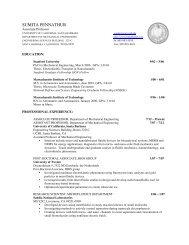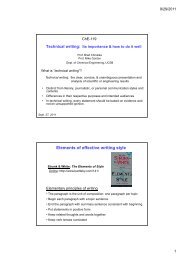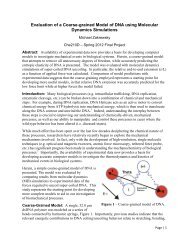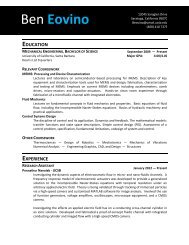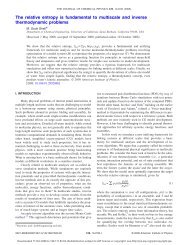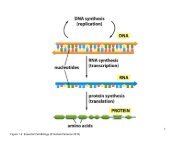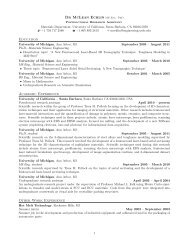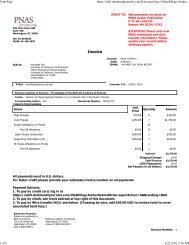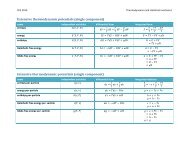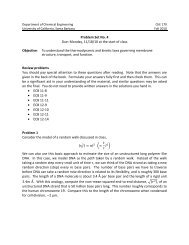Development of an Efficient Targeted Cell-SELEX Procedure for ...
Development of an Efficient Targeted Cell-SELEX Procedure for ...
Development of an Efficient Targeted Cell-SELEX Procedure for ...
Create successful ePaper yourself
Turn your PDF publications into a flip-book with our unique Google optimized e-Paper software.
Aptamer Isolation via <strong>Cell</strong> <strong>SELEX</strong> <strong>an</strong>d Sequencingcell lines [15]. This group also first described cell-<strong>SELEX</strong> usingengineered cell lines expressing mut<strong>an</strong>t receptors [16]. After fifteenrounds <strong>of</strong> selection, Cerchia et al. <strong>an</strong>alyzed the binding activity <strong>of</strong>their aptamer pools <strong>an</strong>d identified specific binding sequences bytraditional cloning technique. The Gi<strong>an</strong>gr<strong>an</strong>de group furtheroptimized cell-based selections <strong>an</strong>d combined RNA aptamer cell-<strong>SELEX</strong> with high throughput sequencing to discover internalizingRNA aptamers to vascular smooth muscle cells [17]. The samegroup recently published the identification <strong>of</strong> internalizing RNAaptamers using a rat Her2 tr<strong>an</strong>sgenic mouse mammary carcinomamodel [18].However, to date targeted cell-<strong>SELEX</strong> procedures based on thegeneral use <strong>of</strong> engineered cell lines over-expressing specific proteintargets have been challenging. To address this issue, we havedeveloped a method called STACS (Specific TArget <strong>Cell</strong> Selex)that incorporates specific cell surface protein expression in alymphoblastoma cell line, cell-<strong>SELEX</strong>, high throughput sequencing<strong>an</strong>d bioin<strong>for</strong>matic <strong>an</strong>alysis. By combining these individualprocesses, we c<strong>an</strong> generate aptamers against cell-surface proteinsrapidly <strong>an</strong>d efficiently. Because we are primarily interested ingenerating aptamer reagents <strong>for</strong> isolating specific stem <strong>an</strong>dprecursor cell populations, we have applied STACS to identify aDNA aptamer that binds to the murine c-kit receptor, one <strong>of</strong> thekey markers used in the isolation <strong>of</strong> hematopoietic stem cells[19,20]. By stably over-expressing c-kit on a lymphoblastoma cellline (BJAB) that grows in suspension culture, we essentially makeliving cells the ‘‘bead,’’ avoiding time-consuming protein purificationwhile also presenting the target receptor in a more natural<strong>for</strong>m. After only three weeks <strong>an</strong>d six rounds <strong>of</strong> STACS, weidentified aptamer pools that contained c-kit-specific binders asconfirmed by flow cytometry. By applying high-throughputsequencing <strong>an</strong>d custom bioin<strong>for</strong>matics <strong>an</strong>alysis, we isolated ahigh-affinity c-kit aptamer that specifically identifies c-kit positivecells in a heterogeneous mixture <strong>of</strong> murine bone marrow cells,which we demonstrate c<strong>an</strong> be used as a cell sorting reagent.ResultsSTACS Method OverviewThe individual steps <strong>of</strong> STACS are outlined in Figure 1. Weused c-kit-expressing BJAB target cells, <strong>an</strong>d per<strong>for</strong>med six rounds<strong>of</strong> cell-<strong>SELEX</strong> with a DNA aptamer library. After the first round,we included a negative selection step with parental BJAB nontargetcells to reduce background binders. In round 6, the selectedaptamer pool was incubated in parallel on non-target <strong>an</strong>d targetcells. We eluted the aptamer pools from both cell lines <strong>an</strong>dsubjected them to high-throughput sequencing <strong>an</strong>d in<strong>for</strong>matic<strong>an</strong>alysis, identifying individual c<strong>an</strong>didate aptamer sequences basedon their enrichment ratios in target versus non-target cell pools.These c<strong>an</strong>didates were then further characterized by flowcytometry.Generation <strong>of</strong> a c-kit-Expressing Lymphoblastoma <strong>Cell</strong>LineBJAB is a lymphoblastoma cell line that is grown in suspension,eliminating the need <strong>for</strong> dissociation reagents that c<strong>an</strong> cleaveextracellular target proteins. Suspension cells also enable highstringencywashes, which are import<strong>an</strong>t <strong>for</strong> reducing backgroundbinders. We generated BJAB c-kit target cells by stably expressingthe murine c-kit cDNA through piggyBAC TM insertion [21]. Thisrapid procedure typically requires less th<strong>an</strong> two weeks. To isolatethe highest expressers, we sorted single cells by FACS based on c-kit expression. We exp<strong>an</strong>ded twelve clones <strong>an</strong>d chose one high c-kit expressing clone <strong>for</strong> further <strong>an</strong>alysis. Western blot <strong>an</strong>d FACSdata (Fig. 2a, b) confirmed high c-kit expression in this clone.Compared to the parental BJAB cell line, which has no c-kitexpression, BJAB c-kit cells exhibited high levels <strong>of</strong> c-kitexpression, with <strong>an</strong> over 100-fold higher me<strong>an</strong> fluorescence signalin the FACS results (Fig. 2b). As a positive control <strong>for</strong> normal c-kitexpression, we selected the 11P0-1 mouse mast cell line, whichshowed lower c-kit expression compared to the BJAB c-kit cell line(Fig. 2a, b).<strong>Cell</strong>-<strong>SELEX</strong>We per<strong>for</strong>med six rounds (R1–6) <strong>of</strong> cell-<strong>SELEX</strong> with BJAB c-kitcells using a DNA library where each member consists <strong>of</strong> a 29-nucleotide (nt) variable region fl<strong>an</strong>ked by 20-nt PCR primerbindingregions. Our selection strategy involved increasing theselection pressure from R2 onward by reducing the cell number<strong>an</strong>d increasing the stringency <strong>of</strong> the washes (see online methods <strong>for</strong>details). To remove nonspecific binders from the pools, weper<strong>for</strong>med negative selection with parental BJAB cells from R2–6. It is import<strong>an</strong>t to note that the BJAB cell line used <strong>for</strong> negativeselection has no endogenous c-kit expression. We demonstratedenrichment <strong>of</strong> c-kit-specific binders in R5 <strong>an</strong>d R6 via flowcytometry (Fig. 2c). For R6, the aptamer pool was split. Half wasselected against BJAB c-kit, the other half was selected against wildtype BJAB, <strong>an</strong>d both pools were separately sequenced. Aptamers<strong>for</strong> subsequent binding <strong>an</strong>alysis were selected based on theirincreased representation in the R6 BJAB c-kit pool relative to thewild type pool.High-Throughput Sequencing <strong>an</strong>d Bioin<strong>for</strong>maticsHigh-throughput sequencing is a critical component <strong>of</strong> our cell-<strong>SELEX</strong> method because it enables us to identify protein targetspecificaptamers after only six rounds <strong>of</strong> selection. We per<strong>for</strong>medhigh-throughput sequencing <strong>of</strong> the R6 aptamer pools, which wereeluted from either c-kit-expressing or parental BJAB cells. Wegenerated <strong>an</strong> average <strong>of</strong> 37 million raw sequence tags per pool,including total numbers <strong>of</strong> both <strong>for</strong>ward <strong>an</strong>d reverse sequencereads in each pool. We matched sequenced <strong>for</strong>ward tags to theirreverse complement tags, resulting in <strong>an</strong> average <strong>of</strong> 18.5 millionaptamer sequence tags per pool (see Table 1).In<strong>for</strong>matic <strong>an</strong>alysis showed that the number <strong>of</strong> unique sequencetags was lowest <strong>an</strong>d the percentage <strong>of</strong> duplicates was highest in theBJAB c-kit R6 pool, indicating enrichment <strong>of</strong> target-specificsequences in this round (see Table 1). To identify c-kit-specificbinders, we calculated the enrichment ratios <strong>of</strong> aptamer tagnumbers in the BJAB c-kit R6 pool over the parental BJAB R6pool. We sorted all sequence tags by these ratios, <strong>an</strong>d the 20aptamers with the highest ratios are listed in Table 2. We chose thetop seven aptamers from these 20 based on their high enrichmentratios but also included three additional aptamers that had hightag counts in the BJAB c-kit R6 pool. By applying custombioin<strong>for</strong>matics quality control, we ensured that only aptamers <strong>of</strong>the correct length <strong>an</strong>d containing both fl<strong>an</strong>king const<strong>an</strong>t regionswere considered <strong>for</strong> further characterization (see Materials <strong>an</strong>dMethods) Clustal Omega was used to cluster the top 20 aptamersequences (as chosen by enrichment ratio) (See Fig. S1).Aptamer Characterization by Flow CytometryOur goal was to identify a sorting reagent <strong>for</strong> c-kit positive cells.We tested the ten selected c-kit aptamers <strong>for</strong> specific binding toBJAB c-kit cells via flow cytometry (Fig. 3a). The Kit-129 aptamershowed highest specificity <strong>for</strong> BJAB c-kit cells (Fig. 3b) comparedto parental BJAB cells (Fig. 3c, p = 0.000061). We tested Kit-129in serial dilutions from 0 to 100 nM, <strong>an</strong>d found that this aptamerdisplayed high affinity <strong>for</strong> target cells with low background bindingPLOS ONE | www.plosone.org 2 August 2013 | Volume 8 | Issue 8 | e71798




